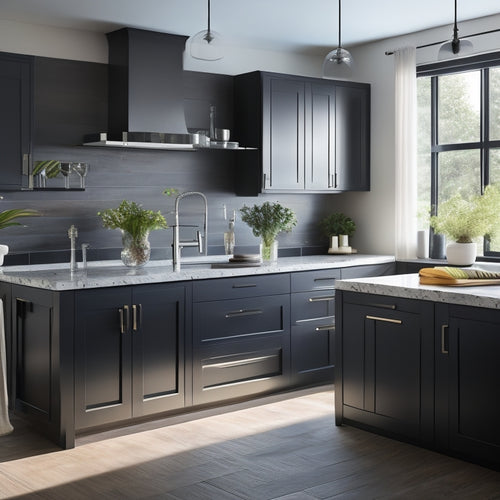
5 Essential Tips for Decluttering Kitchen Cabinets
Share
You're ready to tackle that cluttered kitchen cabinet situation! Start by clearing everything out and categorizing items to see what you really need. Be ruthless when purging unnecessary items - it's liberating, we promise! Next, group similar items together and assign a home for each one, making sure it's easy to access and identify. Don't forget to utilize that vertical storage space with shelves, hooks, or pegboards. As you get organized, you'll start to feel a sense of clarity and control. Now, take it to the next level by optimizing your cabinet space for maximum efficiency.
Key Takeaways
• Start with a clean slate by clearing out kitchen cabinets, removing everything, and identifying needed items to declutter and optimize space.
• Purge unnecessary items first, being ruthless with broken, expired, or useless items to avoid decision fatigue and emotional attachment.
• Categorize and group similar items, designating specific zones for each category, labeling zones clearly, and using containers to store items within zones.
• Assign a home for each item, designating a spot, maintaining organization, and creating a labeling system for easy identification and accessibility.
• Utilize vertical storage space by installing shelves, hooks, or pegboards to maximize storage capacity and keep frequently used items within easy reach.
Start With a Clean Slate
Clear everything out of your kitchen cabinets, sorting items into categories like 'keep,' 'donate,' and 'discard' to get a thorough view of what you're working with. This step is pivotal for a successful Kitchen Refresh and Cabinet Reboot.
You'll be amazed at how much clutter has accumulated over time, and it's important to confront it head-on. Remove everything from your cabinets, including shelves and drawers, and sort items into their respective categories.
This process will help you identify what you truly need, what can be donated or repurposed, and what's simply taking up valuable space. Take your time, and be ruthless – if you haven't used it in the past year, it's probably safe to let it go.
As you sort, consider the items you use daily and how you can optimize your cabinet space to make meal prep and cooking more efficient. With a clean slate, you'll be ready to tackle the next steps in your Kitchen Refresh journey.
Purge Unnecessary Items First
Now that you've sorted your kitchen cabinet contents into categories, tackle the 'discard' pile first, getting rid of anything broken, expired, or simply useless. This will help you avoid Decision Fatigue, which can set in when you're faced with too many options. Be ruthless – if you haven't used it in the past year, it's likely you won't miss it.
As you purge, be aware of Emotional Attachment. It's easy to get sentimental about certain items, but remember, they're just things. Ask yourself if keeping them truly brings you joy or serves a purpose. If not, let them go. You'll be surprised at how liberating it feels to release the weight of unnecessary possessions.
Don't worry about the 'what-ifs' or 'maybes.' If you haven't used it, it's likely someone else can benefit from it. Donate, recycle, or discard items that no longer serve you. This will create space for the things that truly matter, and you'll be left with a sense of clarity and control.
Categorize and Group Similar Items
Organize your remaining kitchen items into categories, such as baking supplies, cooking utensils, and dinnerware, to create a sense of order and make it easier to find what you need when you need it. This step is essential in decluttering your kitchen cabinets, as it helps you visualize the items you have and how they can be grouped together.
For instance, you can categorize your baking supplies into subgroups like flour, sugar, and baking powder, making it easier to access them when you're baking.
Next, designate specific zones within your cabinets for each category. Label these zones clearly, so you can quickly identify where everything goes. This will also help you maintain your newly organized space. Consider using container options like baskets, bins, or dividers to store items within each zone. These will keep similar items together and prevent clutter from building up again.
Assign a Home for Each Item
Designate a specific spot within each zone for every item, ensuring that everything has a designated place where it will be stored and easily accessible when needed. This step is essential in maintaining the organization you've achieved so far. By assigning a home for each item, you'll be able to find what you need quickly and efficiently, saving you time and reducing frustration.
Create a labeling system that works for you, whether it's using labels, stickers, or chalkboard markers. This will help you and others in your household understand where items belong.
Consider investing in customized compartments or dividers to further categorize and separate items within each zone. For example, you could have a compartment for baking supplies, another for cooking utensils, and so on.
Utilize Vertical Storage Space
Maximize your kitchen cabinet's storage potential by making the most of its vertical space, installing shelves, hooks, or a pegboard to keep frequently used items within easy reach. This will help you utilize the often-wasted space between shelves and keep your kitchen clutter-free.
By installing shelves, you can double or even triple your storage capacity, allowing you to store more items without taking up valuable floor space. You can also use baskets or bins to store smaller items like spices, oils, or condiments.
Another great option is to install pegboards. These allow you to hang items like pots, pans, utensils, and even cleaning supplies, keeping them organized and easily accessible.
You can also customize your pegboard by adding hooks, bins, or other accessories to fit your specific needs. By maximizing your shelves and installing pegboards, you'll be able to store more items in less space, making your kitchen feel more organized, calm, and functional.
Frequently Asked Questions
How Do I Handle Kitchen Items With Sentimental Value?
When dealing with sentimental kitchen items, you're not just handling objects, you're managing emotional attachment. Consider displaying cherished family heirlooms, taking photos, or repurposing them to preserve memories while letting go of the physical item.
Can I Reuse Old Kitchen Cabinet Shelves or Must I Replace Them?
'Fresh from freeing sentimental items, you're faced with worn shelves. You can refinish or replace them. Opt for Shelf Refinishing to revitalize, or choose Cabinet Restoration for a complete makeover, giving your kitchen a brand-new vibe.'
What Is the Best Way to Clean Sticky Kitchen Cabinet Drawers?
To tackle sticky kitchen cabinet drawers, you'll want to remove everything, wipe them down with a gentle cleaner, and dry thoroughly. Then, add drawer dividers to keep items organized, giving your cabinet a rejuvenating update with a cabinet refresh.
How Often Should I Declutter My Kitchen Cabinets to Maintain Organization?
You'll want to declutter your kitchen cabinets every 3-6 months with a seasonal purge, and implement a cabinet rotation to maintain organization, ensuring your space stays clutter-free and functional, making you feel more at ease in your kitchen.
Are There Any Eco-Friendly Kitchen Cabinet Organization Products Available?
You're probably surrounded by clutter, but craving eco-friendly solutions! Luckily, you'll find sustainable materials and green alternatives for kitchen cabinet organization, such as bamboo shelves, recycled plastic bins, and repurposed wooden crates.
Related Posts
-

Mastering the Art of Darkroom Photography
You're about to enter a precise, hands-on world where you'll enhance your photographic vision into museum-quality pri...
-

Streamlined Kitchen Sink Organization Solution
A streamlined kitchen sink organization solution must balance functionality with aesthetics. A well-designed system s...
-

Revolutionize Your Kitchen With Sink Upgrades
Revamp your kitchen by enhancing your sink with thoughtfully chosen accessories, transforming it into a multitasking ...


